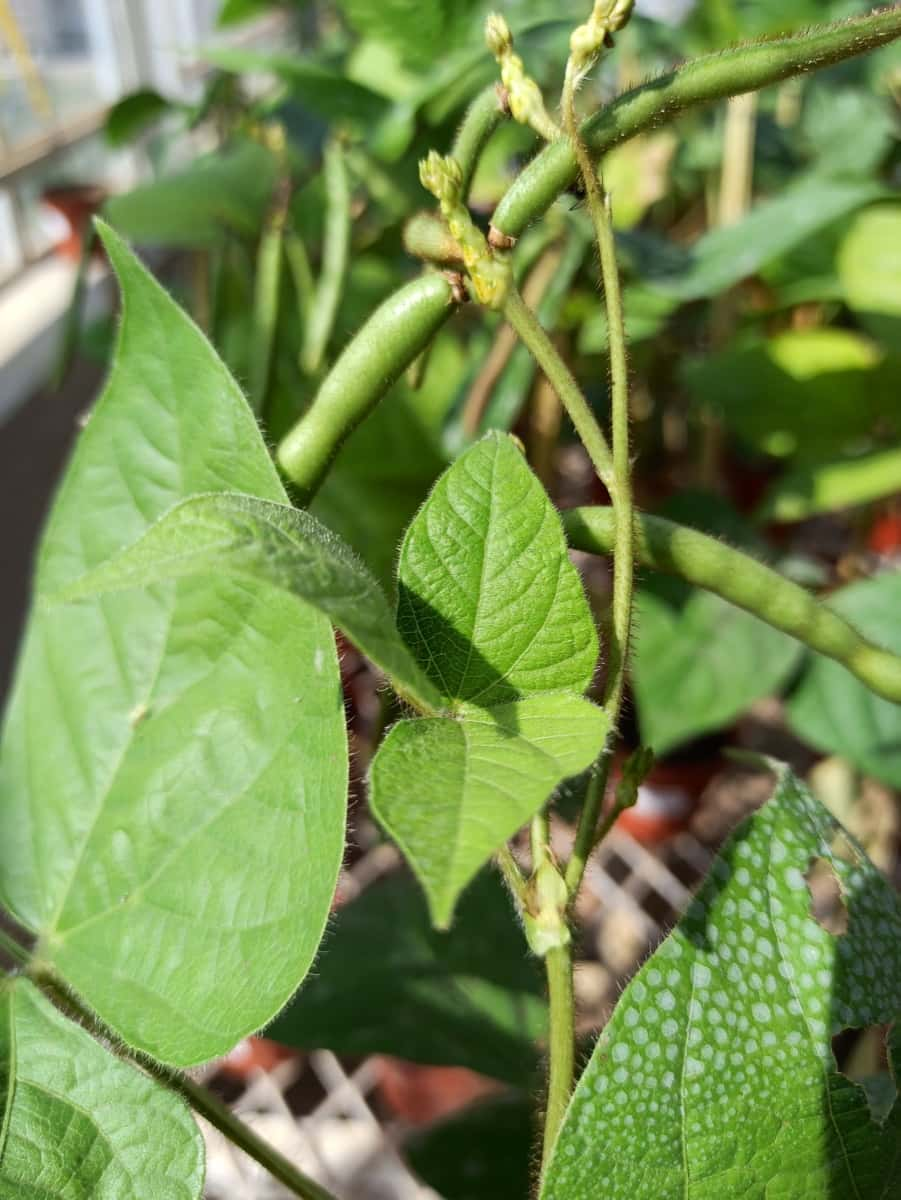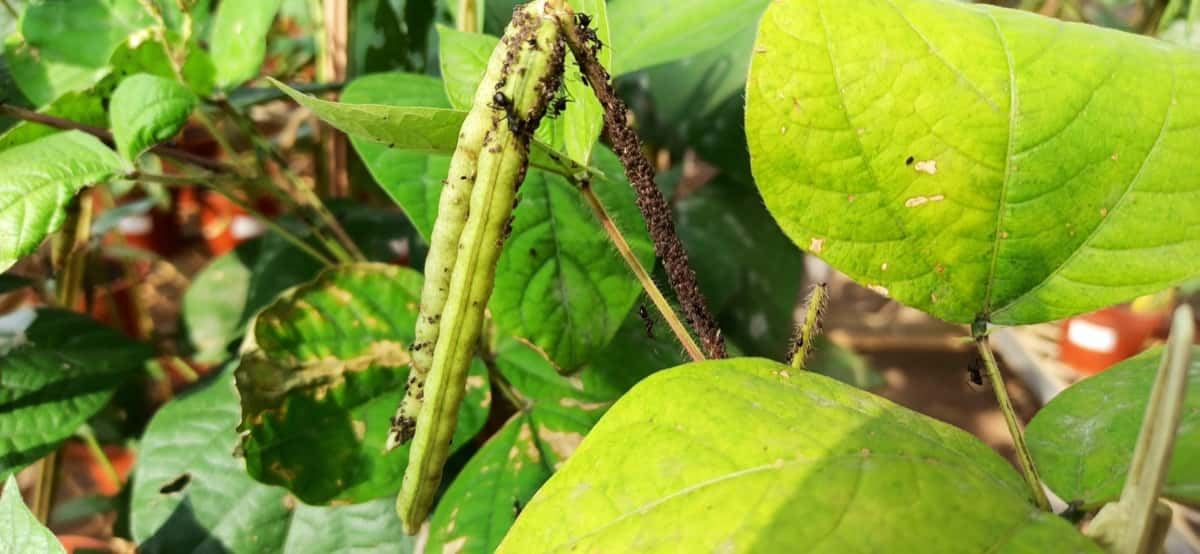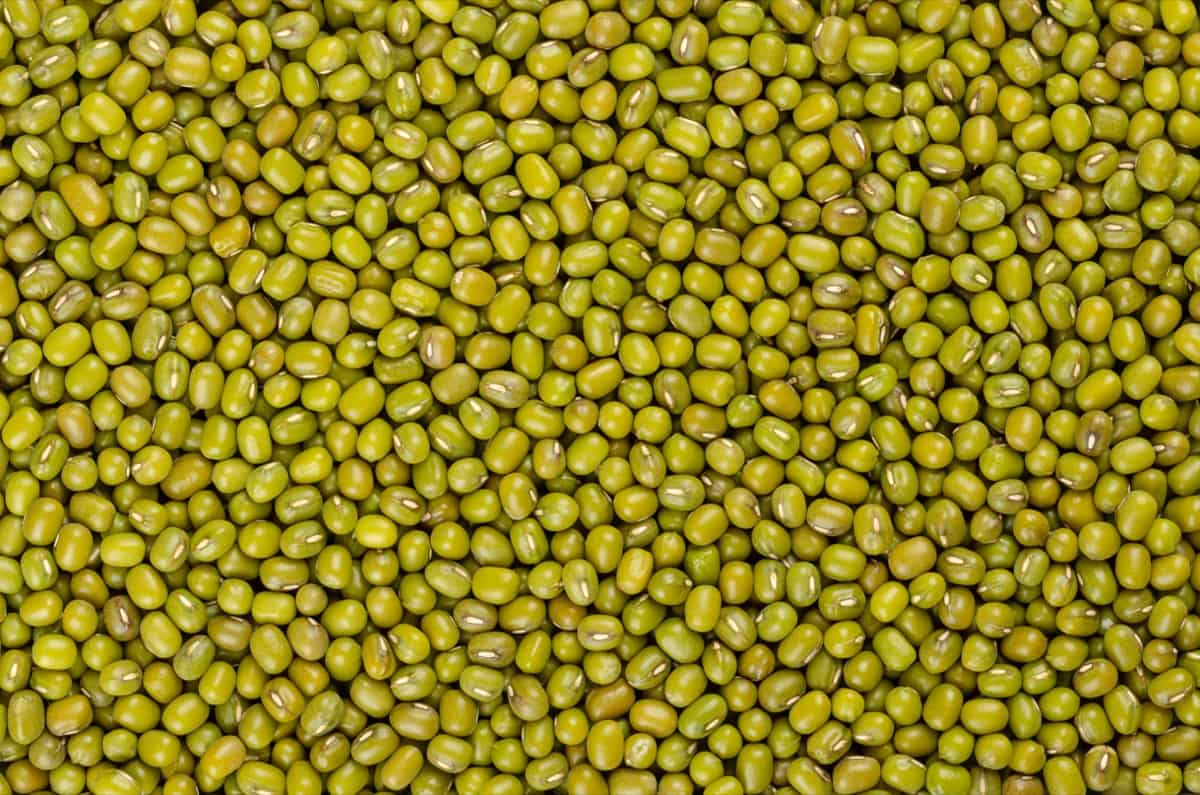The Bean Aphid (Aphis fabae) is a notorious insect pest that infests many crops, including green gram (Vigna radiata). It is a small, soft-bodied insect with a pear-shaped body ranging from light green to dark green or black. It feeds on plant sap using piercing and sucking mouthparts, causing significant damage to the plant and reducing its yield. Bean Aphid that belongs to the family Aphididae in the order Hemiptera.

It has a cosmopolitan distribution, including India, Africa, Argentina, China, the United States, Europe, and Australia. Bean Aphid feeds on various host plants, including groundnut, red gram, peas, beans, safflower, lablab, and niger. This insect can cause significant damage to crops by sucking sap from the plants, reducing their growth and yield. Bean Aphids reproduce rapidly, and their population can grow quickly, particularly in warm and humid conditions.
Therefore, early detection and control measures are essential to prevent significant damage to green gram crops. Integrated pest management (IPM) is an effective strategy for managing Aphids in green gram. Crop rotation, resistant varieties, and crop sanitation can lower Aphid numbers. Ladybirds, lacewings, and parasitic wasps can also control Aphids. Insecticides are an alternative because they harm the environment and non-target organisms. If necessary, use low-toxicity insecticides at the recommended rates and timing.
Bean Aphid Management in Green Gram
Identification of Bean Aphid
Bean Aphids (Aphis craccivora) can be identified by their physical characteristics. Both nymphs and adults are small, soft-bodied insects with pear-shaped body that varies in color from yellow-green to black. They have long legs, antennae, and two small, protruding structures called cornicles on their abdomen.
These cornicles secrete a waxy substance that helps protect the Aphids from predators and environmental stress. The dark color of the bean Aphid makes it easier to spot on the host plant. The nymphs of the bean Aphid are similar in appearance to the adult but are smaller and lack wings.
The Life Cycle of Bean Aphid
Bean Aphids (Aphis craccivora) have a short life cycle, averaging 3-8 days. They reproduce parthenogenetically and viviparously, meaning that females give birth to live young without needing fertilization. The greenish-black colored female can produce 8-30 offspring during their 10-12 day lifespan. The offspring are called nymphs, and they undergo four instars before maturing into adults in 5-8 days. The entire life cycle of bean Aphids occurs on the host plant and can result in rapid population growth if left unchecked.
Causes/Conditions Favorable for Bean Aphid Spread in the field
bean Aphids (Aphis craccivora) are a major pest because they flourish in warm, dry climates. They prefer to feed in colonies on the underside of juvenile, well-fed leaves and shoot tips, where they extract plant sap with their piercing and sucking mouthparts. Succulent plant tissues and new growth stimulate population growth. Bean Aphids usually show up in late spring or early summer and do a lot of damage to crops.
Damage Symptoms of Bean Aphid
Bean Aphids (Aphis craccivora), which feed on plant sap, severely damage green grams. Dark-colored Aphids blanket infected leaves, inflorescence stalks, and young pods. Along with feeding, Aphids produce honeydew, a sugary substance that draws ants and encourages the development of dark sooty mold on foliage.
In case you missed it: Whitefly Management in Green Gram: Symptoms, Identification, Treatment, Chemical, Biological, Natural, and Organic Control

Nymphs and adults can harm plants, causing infected pods to deform and wither. Severe infestations may cause the affected pods to dry out, lowering output completely. Furthermore, bean Aphids serve as a vehicle for the pea virus, causing additional agricultural harm.
Yield Loss Due to Bean Aphid on Green Gram
Bean Aphids (Aphis craccivora) can reduce the yield of green gram (mung bean). According to studies, insect pests like bean Aphids can reduce yield by 30% annually. This may negatively impact the production of crops and farmer income. Bean Aphids cause pod distortion, withering, and crop loss.
Bean Aphid Management in Green Gram by Cultural Method
- Early planting of the crop to avoid peak Aphid infestation periods
- Regular field inspections to detect the presence of Aphids
- Removal of weed hosts that can harbor Aphids
- Use of resistant or tolerant varieties of green gram
- Soil tillage to disrupt Aphid breeding and feeding sites
Bean Aphid Management in Green Gram by Biological Method
- Introduction of natural enemies, such as parasitic wasps and predatory insects, that feed on bean Aphids
- Use of microbial agents, such as Beauveria bassiana and Metarhizium anisopliae, that infect and kill Aphids
- Encouragement of beneficial insects, such as ladybirds and lacewings, by reducing pesticide use and conserving habitats
- The use of biopesticides, such as neem and garlic extracts, has insecticidal properties and can effectively control Aphid populations.
Bean Aphid Management in Green Gram by Chemical Method
- Emamectin benzoate 5% SG can be sprayed at 220 g/ha to control Aphid populations in green gram effectively.
- Indoxacarb 15.8% SC can be sprayed at 333 ml/ha to control Aphids in green gram. It has a longer residual activity and provides better control than other insecticides.
- NSKE 5% can be sprayed twice, followed by triazophos 0.05% to control Aphids in green gram. This method provides good control and is also eco-friendly.
Bean Aphid Management in Green Gram by Organic/Natural Method
- Neem oil of 2% can be sprayed to control Aphid populations in green gram. It is a natural and eco-friendly option but may require more frequent applications than synthetic insecticides.
- Natural insecticides such as garlic, chili, and neem extracts can effectively control Aphids in green gram.
- Cultural practices such as crop rotation, intercropping, and planting resistant varieties can help reduce Aphid populations in green gram.
- Physical barriers like floating row covers or netting can prevent Aphids from infesting the crop.
Preventive Measures for Control of Bean Aphid
- Use resistant or tolerant varieties of green gram, if available, to reduce the risk of Aphid infestations.
- Monitor green gram regularly for Aphid infestations and take prompt action if needed, such as removing affected shoots and branches.
- Avoid excessive use of nitrogenous fertilizers, which can increase the susceptibility of a green gram to Aphid infestations.
- Use organic and natural methods, such as neem oil or releasing natural enemies, to control Aphid populations instead of relying solely on chemical pesticides.
- Practice good field hygiene by removing plant debris and weeds that can harbor Aphids and their natural enemies.
- Rotate crops to prevent the buildup of Aphids in the soil.
- Promote biodiversity in the field by planting companion crops or intercropping with plants that attract natural enemies of Aphids.
In case you missed it: Spotted Pod Borer Management in Green Gram: Symptoms, Identification, Treatment, Chemical, Biological, Natural, and Organic Control

Conclusion
Bean Aphids are a common pest of green gram that can yield losses. Early identification and timely management using cultural, biological, chemical, and natural methods are crucial in preventing and controlling infestations. Organic methods such as neem oil and garlic extract can reduce Aphid populations.
- Beneficial Insects in Pest Management
- Natural Solutions for Pest Control in Flower Gardens
- Types of Fungicides Used in Agriculture
- Common Issues in the Fruit Development Stage of Pomegranate Farming
- Fruit Development Issues in Papaya: Easy Solutions and Treatment
- Soil-Borne Diseases and How to Protect Your Plants
- Practices to Prevent Disease Spread in the Garden
- From Wilted to Thriving: How to Treat Root Rot Naturally in Houseplants
- Natural Remedies to Cure Brown Spots on Fig Tree Leaves